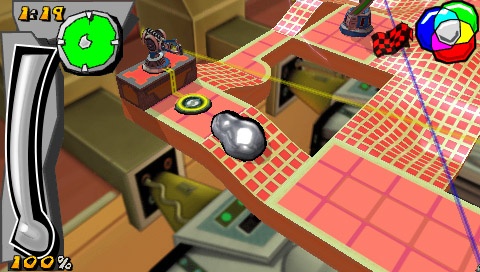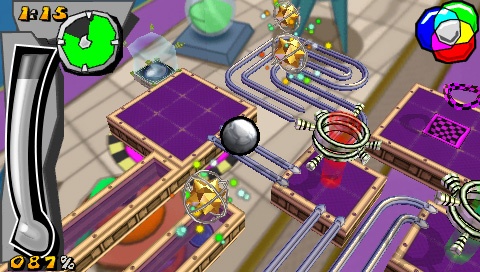Mercury Meltdown Hands-On
We visit Ignition and get our hands on the upcoming sequel to the PSP launch title Mercury.
The original Mercury was a launch title for the PlayStation Portable, and it went on to be one of the first third-party Western titles to be published by Sony in Japan. Now, the follow-up is almost ready to be released, having been in development at Ignition Entertainment, which was formerly Awesome Studios. Mercury Meltdown follows the same basic principles of its predecessor, challenging players to navigate a blob of liquid metal through various puzzles that gradually increase in difficulty. The new game promises to expand upon its predecessor via a number of new features, while also giving the package a graphical overhaul. We visited Ignition's UK headquarters to play an advanced version of Mercury Meltdown before the worldwide release this September.
Whereas the original Mercury featured a very industrial visual aesthetic, Mercury Meltdown has a much more rounded, cartoon feel to it. The team has already run into some vocal concerns over the decision to give the mercury blob a thick, black border, but in practice, it gives the substance much more definition and physicality. The original blob style has also been included to appease fans of the first game, but the team at Ignition has been very clear in their wish to make Mercury Meltdown more accessible and less stylised than its predecessor.

The main game features eight themed science labs, each comprising 16 levels and one bonus level. Each level is identified by a test tube, which is filled up depending on how much mercury you have at the end of each level. Just as before, the liquid metal is rolled around levels that are suspended in midair, and you can lose a percentage of the substance while still completing the level. If you manage to get 100 percent of the mercury to the finish of each level within the time limit, the test tube is filled up and a cork is placed in the top. After doing this, you're encouraged to go back and collect the bonuses in each level, most of which are fiendishly placed and difficult to get to. At least you don't have to worry about the time limit when you're collecting the bonuses, though, and if you manage to get all the bonuses within each level, you'll get a star on your test tube. Finally, if you get the top score, you'll get another badge on the test tube, and the cork will turn gold to show that you've mastered the level. If you're skilled enough to do this on each of the 16 levels within each lab, you'll open up a bonus level. There are two more bonus labs to work your way up to if you can master all eight labs, as well.
During our play test, the levels became tough quite early on, but Ignition has designed what it calls a 'saw' difficulty structure, where a hard challenge will be followed by an easier level to encourage progression. You can also progress through the game without having to master each level if you wish, as each set of levels has an overall mercury meter that unlocks the next lab when full. This lets you make up for levels in which you're struggling by building up scores on the levels you can ace.
In addition to unlocking new labs, progression through the main mode also unlocks five party games, which are novel twists on the main themes. The racing game has clearly been inspired by F-Zero, as you drive your blob of mercury at high speeds with the aim of staying on the track and recording a fast time. Rodeo is an excellent idea, where the aim is quite simply to keep the blob on a platform while a fan rotates around you to blow you off. If you can collect bonuses, you can keep the speed of the fan down to a minimum, but just like a real rodeo, you'll eventually fall off. Metrix is a Tetris-esque puzzle game in which you create blocks of colours and match them in sets of three to make them disappear. Shove is basically a mercury version of the winter sport curling, where you need to aim your blob toward a target and then set the speed at which you want to propel it. You can make the blob heavier or lighter to slow it down or speed it up, respectively, and you can multiply your score by aiming at the bonuses and bouncing the blob off the walls on its way to the target. Paint, the final party game, is one in which your mercury blob leaves a trail of coloured paint as it moves around. The idea is to colour more of the board than your opponent while under a time limit, and there are power-ups such as paint bombs that help you to do this.

Every single level and party game in Mercury Meltdown can be played by up to two players over the PSP's ad hoc wireless connection. We tried the multiplayer out with a member of the QA department at Ignition, and despite being trounced by our opponent's far-superior skills, the game is an enticing proposition in this mode. The main game is enhanced by the introduction of power-ups, as they make the game particularly unpredictable. For example, our opponent used a power-up to turn the lights out on our screen at one point, and we also saw collectibles that will let you swap position with the other player or simply to smash them into tiny pieces. You can also send an eight-level demo of the game to other PSP users using the game-share option.
Ignition has implemented a host of new features in Mercury Meltdown. The game now automatically saves progress, so any high scores or levels that you unlock are stored to the Memory Stick upon completion. There are also new mercury skins that can be unlocked as you progress through the game, including pool balls, wheels and--strangely--a dog's head. We tried out the unlockable traffic-sign skin, which changed numbers depending on the density of the mercury. There are four different states that the mercury can take in this game, which include the regular liquid form, as well as solid, fast, and slow. Cleverly, if the blob is taking the fast form, the number on the traffic-sign skin changes to '70', and if it's dense, the number goes down to '10'. The mercury blob now has convincing reflectivity, and if you zoom the camera in, it's easier to see which direction the blob is rolling in. A set of tutorial levels have also been included, which introduce players to each of the various gameplay features. These include the ability to turn mercury into different colours, make it more fluid or solid, and flip it into the air. There's also a training ground that lets you get to grips with all the machinery in the game, an aspect which can make the blob increasingly difficult to control as you progress through the game.
Mercury was such a challenging game toward the later levels that hardcore players like to upload their best performances onto the Internet to be appreciated by fans. Mercury Meltdown lets you save replays of your best performances, as well as store a ghost replay of your results. These ghost replays are automatically loaded if you replay the level in question.
Mercury Meltdown promises to be a more refined take on the original puzzle game, and while the new graphical style might upset some fans, it's almost certain to win over a wider audience. The level design looks as fiendish as ever, and the new multiplayer modes make an excellent addition to an already large package. We'll bring you more information on Mercury Meltdown as soon as it becomes available.
Got a news tip or want to contact us directly? Email news@gamespot.com
Join the conversation